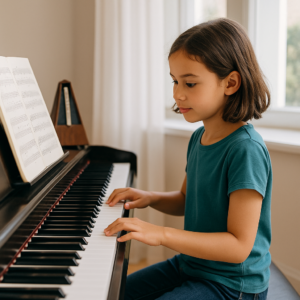5 Practice Techniques to Improve Piano Skills: A Beginner’s Guide from Private Music Teachers
As a collective of dedicated music educators specializing in private lessons for beginners, we understand the challenges new pianists face. Developing effective practice habits early on is crucial for progress. Here are five essential techniques to help beginners enhance their piano skills.
1. Set Clear Practice Goals
Before each session, define specific objectives. Whether it’s mastering a particular scale, improving a section of a piece, or enhancing hand coordination, having clear goals provides direction and motivation. This focused approach ensures productive practice sessions.
2. Use a Metronome
Timing is fundamental in music. Incorporating a metronome into practice helps maintain a steady tempo and develop rhythmic precision. Start slowly, ensuring accuracy, and gradually increase speed as confidence builds. Consistent use of a metronome can significantly improve timing and overall performance.
3. Practice Without Pedals
Beginners often rely heavily on the sustain pedal, which can mask technical imperfections. Practicing without pedals encourages clean finger technique and clarity of notes. Once proficiency is achieved, reintroduce the pedal to enhance musical expression.
4. Focus on Legato Playing
Legato, or smooth, connected playing, is essential for expressive performance. Concentrate on transitioning seamlessly between notes, ensuring each tone flows into the next without gaps. This technique enhances musicality and develops finger control.
5. Break Down Pieces into Sections
Tackling an entire piece at once can be overwhelming. Divide compositions into manageable sections, focusing on one segment at a time. This method allows for concentrated practice, making it easier to identify and address challenging areas.
Further Resources:
-
Explore our blog on practice techniques for more insights.
-
Discover additional tips in this Piano Practice Routine for Beginners.
Conclusion:
Implementing these practice techniques to improve piano skills can accelerate a beginner’s progress and build a strong foundation. Consistent, focused practice, combined with guidance from experienced instructors, paves the way for musical growth and enjoyment.
